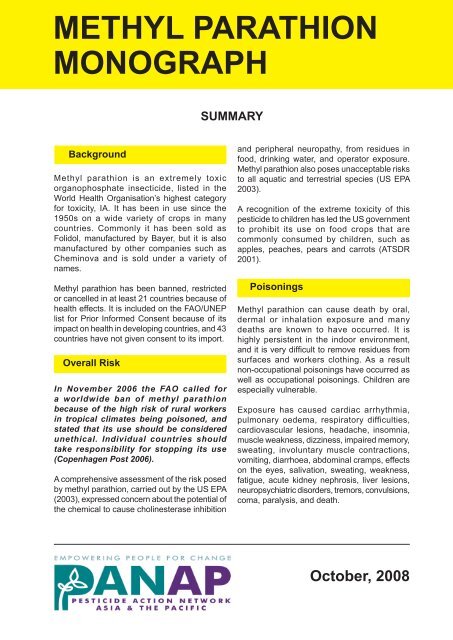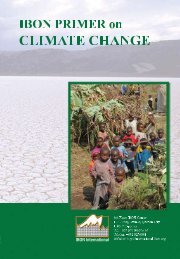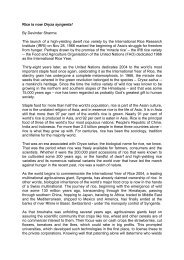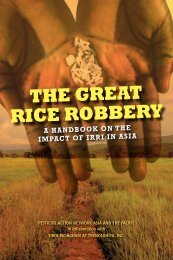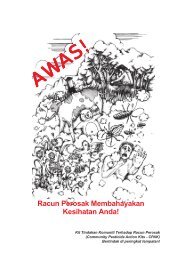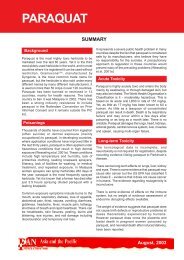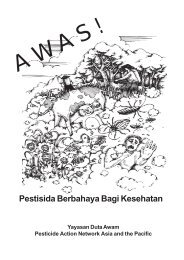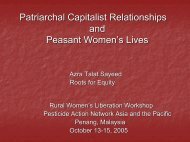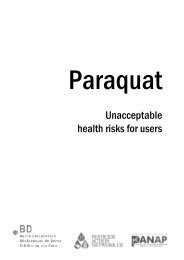METHYL PARATHION MONOgRAPH SUMMARY - PAN AP - Home
METHYL PARATHION MONOgRAPH SUMMARY - PAN AP - Home
METHYL PARATHION MONOgRAPH SUMMARY - PAN AP - Home
You also want an ePaper? Increase the reach of your titles
YUMPU automatically turns print PDFs into web optimized ePapers that Google loves.
<strong>METHYL</strong> <strong>PARATHION</strong>MonographMethyl Parathion<strong>SUMMARY</strong>BackgroundMethyl parathion is an extremely toxicorganophosphate insecticide, listed in theWorld Health Organisation’s highest categoryfor toxicity, IA. It has been in use since the1950s on a wide variety of crops in manycountries. Commonly it has been sold asFolidol, manufactured by Bayer, but it is alsomanufactured by other companies such asCheminova and is sold under a variety ofnames.Methyl parathion has been banned, restrictedor cancelled in at least 21 countries because ofhealth effects. It is included on the FAO/UNEPlist for Prior Informed Consent because of itsimpact on health in developing countries, and 43countries have not given consent to its import.Overall RiskIn November 2006 the FAO called fora worldwide ban of methyl parathionbecause of the high risk of rural workersin tropical climates being poisoned, andstated that its use should be consideredunethical. Individual countries shouldtake responsibility for stopping its use(Copenhagen Post 2006).A comprehensive assessment of the risk posedby methyl parathion, carried out by the US EPA(2003), expressed concern about the potential ofthe chemical to cause cholinesterase inhibitionand peripheral neuropathy, from residues infood, drinking water, and operator exposure.Methyl parathion also poses unacceptable risksto all aquatic and terrestrial species (US EPA2003).A recognition of the extreme toxicity of thispesticide to children has led the US governmentto prohibit its use on food crops that arecommonly consumed by children, such asapples, peaches, pears and carrots (ATSDR2001).PoisoningsMethyl parathion can cause death by oral,dermal or inhalation exposure and manydeaths are known to have occurred. It ishighly persistent in the indoor environment,and it is very difficult to remove residues fromsurfaces and workers clothing. As a resultnon-occupational poisonings have occurred aswell as occupational poisonings. Children areespecially vulnerable.Exposure has caused cardiac arrhythmia,pulmonary oedema, respiratory difficulties,cardiovascular lesions, headache, insomnia,muscle weakness, dizziness, impaired memory,sweating, involuntary muscle contractions,vomiting, diarrhoea, abdominal cramps, effectson the eyes, salivation, sweating, weakness,fatigue, acute kidney nephrosis, liver lesions,neuropsychiatric disorders, tremors, convulsions,coma, paralysis, and death.October, 2008
Methyl Parathionthe more harmful methyl paraoxon. Methylparathion and its metabolite may be transferredvia the placenta to the developing foetus(Edwards & Tchounwou 2005).Acute toxicityMethyl parathion interferes with the normalfunctioning of the nervous system andbrain, primarily by inhibiting the enzymeacetylcholinesterase, which causes theaccumulation of the neurotransmitteracetylcholine at nerve endings. This results inover stimulation of the nervous system (ATSDR2001).• WHO Recommended Classificationby Acute Hazard: Class 1a, extremelyhazardous (FAO/UNEP 1996).• US EPA (2003) Hazard Classification:= Acute toxicity from oral intake– Category 1, very toxic.= Acute toxicity from dermalabsorption – Category I, verytoxic.= Acute toxicity by inhalation– Category 1, very toxic.Lethal dosesLethal dose, LD 50, is the dose that kills 50 percent of test animals:• Oral LD 50(rat)= 4.5-24mg/kg body weight (US EPA2003)= 3mg/kg bw (FAO/UNEP 1996)• Dermal LD 50(rat)= 40mg/kg bw (FAO/UNEP 1996)= 67-120mg/kg (ATSDR 2001)• Inhalation LC 50(rat)=
Methyl Parathion•68 day half-life for apples in a controlledatmospherestorage room (ATSDR2001).AbsorptionMethyl parathion is readily absorbed via allroutes of exposure (oral, dermal, inhalation)and is rapidly distributed to the tissues of thebody (IPCS 1993; ATSDR 2001).It is transferred across the placenta to theunborn foetus (ATSDR 2001).It has been found in human breast milk inTurkmenistan, Tajikistan and Kazakhstanand can be transferred to the newborn infantthrough breast feeding (ATSDR 2001).TreatmentPeople who have been poisoned should beimmediately taken to hospital and placed undersurveillance by properly trained medical staff.General surveillance and cardiac monitoringshould continue for 14 days. Antidotes areatropine sulfate and pralidoxime chloride (FAO/UNEP 1996).Symptoms and consequences ofpoisoningsCases of acute methyl parathion poisoning showsymptoms characteristic of poisoning by othercholinesterase-inhibiting organophosphatecompounds:• inhalation causes bloody or runny nose,coughing, chest discomfort, difficult or shortbreath, and wheezing due to constrictionor excess fluid in bronchial tubes;• skin contact causes localised sweating,involuntary muscle contractions;• eye contact causes pain, bleeding, tears,pupil constriction, and blurred vision (FAO1997).Systemic effects may follow within a fewminutes or be delayed up to 12 hours:• pallor, nausea, vomiting, diarrhoea,abdominal cramps, headache, dizziness,eye pain, blurred vision, constrictionor dilation of pupils, tears, salivation,sweating, confusion (FAO 1997).• acute nephrosis of the kidney, liver lesions(Edwards & Tchounwou 2005).Severe poisoning can affect the centralnervous system causing:• incoordination, slurred speech, loss ofreflexes, weakness, fatigue, involuntarymuscle contractions, twitching, tremorsof the tongue or eyelids;• involuntary defecation or urination,psychosis, irregular heart beat,unconsciousness, convulsions, coma;• and eventually paralysis of the bodyextremities and respiratory muscles;• death is due to respiratory failure orcardiac arrest (FAO 1997).Patients surviving 24 hours after intoxicationwere found to have degeneration of the heartmuscle (Edwards & Tchounwou 2005).Long-term effectsChronic effects of exposure have been lesswell characterised (Wasley et al 2002). Anincrease in chromosomal aberrations hasbeen reported following acute poisoning(IPCS 1993).No cases of delayed peripheral neuropathyhave been reported according to theATSDR (2001). One report of long-termneuropsychiatric illness in two aerial applicationpilots has been associated with exposure tomethyl parathion. Effects included dizziness,anxiety, emotional lability, frequent and severedisagreements with the family, and inability toperform familiar tasks (ATSDR 2001).Susceptible populationsPeople who have increased susceptibilityto methyl parathion include those withorganic central nervous system disease,mental disorders, epilepsy, pronouncedendocrine disorders, respiratory conditions,cardiovascular disease, circulatory disorders,gastroenteric diseases, liver or kidneydisease, chronic conjunctivitis and keratitis,and pregnant women (ATSDR 2001).Cases of PoisoningsDeaths have occurred from oral, dermal andinhalation exposure (ATSDR 2001).Six cases of methyl parathion poisoningwere reported in Bulgaria between 1965-1968 (FAO/UNEP 1996).
Methyl ParathionEnvironmental EffectsAquatic toxicityFreshwater fishMethyl parathion is highly toxic to freshwaterfish. It causes chronic effects in fish atconcentrations less than 80ppb, includingdeceased weight and length. Other effectsinclude behavioural changes, growth reduction,and indirect mortality (US EPA 2003).AmphibiansIt is moderately toxic to amphibians, includinglarval stages of developing frogs (US EPA2003).Freshwater invertebratesIt is very highly toxic to freshwater invertebrates.Chronic effects include decreased numberof young, decreased survival of young anddecreased growth. Residues in the surfacewaters of lakes Beasley and Deep Hollow in theMississippi Delta have significantly impairedgrowth of the amphipod Hyalella azteca (ashrimp-like crustacean) (Moore et al 2007).Large decreases in invertebrate populationscan lead to algal blooms and subsequent fishkills by depleting dissolved oxygen (US EPA2003).Estuarine/marineIt is very highly toxic to estuarine/marine fishand invertebrates, and causes chronic effectsto the later at low concentrations, including tothe survival and number of offspring. In fish itcauses behavioural changes, cholinesteraseinhibition, and ovarian damage (US EPA 2003).It is also very highly toxic to crustaceans andmoderately toxic to zooplankton (Orme &Kegley 2006).Aquatic plantsIt is moderately toxic to aquatic plants (marinediatoms).Toxic doses• Bluegill sunfish (96hr LC 50) – 1.0ppm• Chorus frog (96hr LC 50) – 3.7ppm• Daphnia, waterflea (48hr LC 50)– 0.14ppb• Marine diatom (EC 50) – 5.3ppm.(US EPA 2003).Terrestrial ecotoxicityBirdsMethyl parathion is very highly toxic to birds,from single oral doses, dermal and shorttermdietary exposures, posing significantacute and chronic risks. Effects include directmortality, decreased egg production, changesin maternal care and viability of young birds,anorexia, increased susceptibility to predation,and greater sensitivity to environmental stress.It can pose a risk to the maintenance of viablepopulations of bird species where its use iswidespread (US EPA 2003).BeesIt is very highly toxic to bees, and likely tocause bee mortality under field conditionsof use, including as foliar residues (US EPA2003). Sublethal concentrations alter foragingbehaviour (Guez et al 2005).MammalsIt is very highly toxic to small mammals, whichare adversely affected through oral, dermaland inhalation exposure. Effects includesignificant decrease in survival of young,and reduction in maternal bodyweight duringlactation (US EPA 2003).•••Acute oral LD 50(Mallard duck) – 6.6mg/kgAcute dermal LD 50(Northern bobwhitequail) – 2.9-9.1mg/kgLD 50(honey bee) – 0.111-0.214ug/bee(US EPA 2003).Beneficial insectsMethyl parathion is highly toxic to beneficialinsects, as it is a broad-spectrum insecticide.One survey found 98-100 percent mortalityof predators of mealybugs on citrus (Wakgari& Giliomee 2003). In laboratory conditionsmethyl parathion 50 EC (0.05 percent), hada direct knockdown effect on the ecologicallyimportant soil micro-arthropod Cyphoderussp (Joy & Chakravorty 1991).Soil Micro-organismsLong-term contamination of soil with methylparathion altered the composition of microbialcommunities including increasing the presenceof gamma-proteobacteria (Zhang et al 2006),a group of bacterial pathogens responsible for10
Methyl Parathiona number of human diseases such as typhoid,cholera, plague, etc.Insecticide resistanceAt least 48 insect species are known to havedeveloped resistance to methyl parathion,making the insecticide ineffective. Theseinclude pests of cotton, apples, potato and othervegetables, rape, corn, sorghum, chickpea,tobacco, cereals, rice, flowers, soybean, andsugarcane, as well as mosquitoes, house fliesand sheep blowfly (Whalon et al 2004).Environmental fate• Soil: degrades rapidly in soil under nonaerobicconditions (flooded soils) withan average half-life of 7 days, but hasan average half-life of 64 days in nonfloodedaerobic soils (ATSDR 2001). Italso degrades faster in alkaline soils. It isrelatively mobile in soils (US EPA 2003).• Water: degrades in water (half-life is 24-28 days). It has been detected in riversin US cotton- and rice-growing regionsranging from 0.42ppb to 6ppb. It has alsobeen detected in high concentrations inriver samples in Nicaragua (Castilho et al2000), and the Ganges in India (Rehanaet al 1996).• Groundwater contamination: has beendetected, for example it was found in 5.45percent of wells sampled in cotton growingdistricts of Punjab, Pakistan (Tariq et al2004).• Ice: residues from historical use havebeen found in ice cores taken fromthe Austfonna ice cap in the Svalbardarchipelago in the arctic (Hermanson etal 2005).• Air/rain: can volatilise from plants andsoil and has been detected in air, rainand fog samples (ATSDR 2001). It hasbeen detected vaporizing from treatedcotton fields 24 hours after spraying (FAO/UNEP 1996). Weekly sampling of air inthe Mississippi River valley found methylparathion in 70 percent of the samples andat the highest concentration (62 ng/m3air) of any insecticide measured in thestudy (Foreman et al 2000). It also hadthe highest concentrations of all pesticidesmeasured in rain (Coupe et al 2000). It hasbeen measured in ambient air breathed byfarmers in Tambon Bang Rieng, Thailand(Jirachaiyabhas et al 2004). It has beenmeasured in the air in the vicinity of methylparathion producing factories (ATSDR2001).• Plants: phytotoxic effects have beenobserved in cotton and lettuce, and areduction of growth has been caused insorghum (US EPA 2003).• Bioaccumulation: reviews generallystate that methyl parathion does notbioaccumulate (e.g. FAO 1997; ATSDR2001). However De La Vega Salazar etal (1997) found that both methyl parathionand its metabolite 4-nitrophenol didbioaccumulate in the tissues of aquaticorganisms in response to environmentalstress. A significant concentration inreproductive tissues (plants) and unbornprogeny (animals) was found in allsamples. ATSDR (2001) suggests thatmethyl parathion sometimes persistslong enough for uptake by fish to occur,and thus could possibly play a role inbioaccumulation.Alternatives to Methyl ParathionAlternative insecticidesThere are many other synthetic chemicalinsecticides on the market, but most of thesealso have a range of adverse health andenvironmental effects, such as endocrinedisruption, cancer, neurological damage,groundwater contamination, persistence,etc. Hence their use is not recommended asreplacements for methyl parathion.There are some insecticides derived fromnatural plant extracts that can kill or repelinsects; some deter insects feeding, or inhibittheir growth. Natural soaps and mineralscan also be used, as can naturally occurringpathogens like Bacillus thuringiensis (Bt) usedas a spray – NOT as a genetically engineeredpart of the crop itself.Care must be taken even with natural plantextracts as some, such as pyrethrum, canhave toxic effects on beneficial insects,animals, and humans. Other plant extractsinclude neem, lemon grass, and galanga.11
Methyl ParathionGenerally an insecticide, even a natural one,should be regarded as the choice of lastresort, with the primary focus being placed onalternative pest management practices thatprevent the need for a spray.Alternative or ecological pestmanagementAlternative or ecological pest managementfocuses on sustainable ecological solutions thatprevent pest build up. It takes a holistic approachto crop management that recognise pests asan integral part of the whole agroecosystem,forming a complex with beneficial insects,weeds, diseases and crops. The self-regulatorymechanisms of a highly biodiverse farmingsystem help keep pest species in balance.Elements of alternative or ecological pestmanagement:•••••••••designing a farm ecosystem thatencourages biodiversity, providing habitatsfor beneficial insects;using resistant, often indigenous, cropvarieties;diversifying crops by intercropping, rotation,and use of multiple varieties;cultural practices that encourage healthysoils and hence healthy plants, suchas fallowing, appropriate tillage, watermanagement, mulching, and use of animalmanures, green manures, vermicasts,composts, liquid bio-fertilisers, andenhanced indigenous micro-organisms;cultural practices that contribute to thesuppression of pest populations suchas varying times of sowing, planting andharvesting, adjusting row width, and useof trap crops;companion planting to deter pests;enhancing the habitats and hencepopulations of natural enemies suchas parasitoids like the Encarsia waspand predators like the damselfly andspiders, as well as birds and snakes whereappropriate;accurate identification of both pests andbeneficial insects and knowledge oftheir life cycles, habitats, and periods ofpopulation expansion and vulnerability;field sanitation – removing infested plantmaterial including crop residues to reducecarryover of pests from one planting tothe next;• systematic scouting of crops for pestsand natural enemies, either regularly orat susceptible times, sometimes involvingthe use of sweep nets, sticky traps, andpheromone traps;• use of mechanical methods such as lighttraps, trenches (e.g. to prevent migrationof rice molluscs into paddy fields),nets, reflective ribbon, bird perches,pheromone traps, sticky board traps, soilbaits, and plant ash.(SIBAT 1999a, 1999b; OISAT 2004).The Online Information Service for PesticideManagement in the Tropics (http://www.OISAT. orgl), established by <strong>PAN</strong> Germany,provides information on managing particularpests in specific crops without the use ofmethyl parathion.ReferencesAGROW 494. 2006. Chinese market growthcontinues to putpace world. AGROW World CropProtection News (494):16. http://www.agrow.co.uk.AGROW 508. 2006. Indian agrochemical outputdeclines. AGROW World Crop Protection News(508):20. http://www.agrow.co.uk.AGROW 509. 2006. Parathion-methyl cutsconfirmed in US. AGROW World Crop ProtectionNews (509):15. http://www.agrow.co.uk.AGROW 526. 2007. China clamps down on illegalOPs. AGROW World Crop Protection News(526):20. http://www.agrow.co.uk.Alvarez R, Honrubia MP, Herraez MP. 1995.Skeletal malformations induced by the insecticidesZZ-Aphox and Folidol during larval developmentof Rana perezi. Arch Environ Contam Toxicol28(3):349-56.Anderson TD, Lydy MJ. 2002. Increased toxicityto invertebrates associated with a mixture ofatrazine and organophosphate insecticides.Environ Toxicol Chem 21(7):1507-14.ATSDR. 2001. Toxicological Profile for MethylParathion. Agency for Toxic Substances andDisease Registry. Atlanta USA. http://www.atsdr.cdc.gov.toxprofiles/tp48.html. Accessed15/11/04.12
Methyl ParathionAzaroff LS, Neas LM. 1999. Acute health effectsassociated with nonoccupational pesticideexposure in rural El Salvador. Environ Res 80(2Pt 1):158-64.Barbalace K. 2006. Chemical Database -Methyl Parathion. EnvironmentalChemistry.com. http://EnvironmentalChemistry.com//yogi/chemicals/cn/Methyl%A0parathion.html.Accessed 11/29/2006.Bretveld RW, Thomas CMG, Scheepers PTJ,Zielhuis GA, Roelevel N. 2006. Pesticideexposure: the hormonal function of the femalereproductive system disrupted? Reprod BiolEndocrin doi:10.1186/1477-7827-4-30. http://www.rbej.com/content/4/1/30.Castilho JA, Fenzl N, Guillen SM, Nascimento FS.2000. Organochlorine and organophosphoruspesticide residues in the Atoya river basin,Chinandega, Nicaragua. Environ Pollut110(3):523-33.Castillo CG, Montante M, Dufour L, Martinez ML,Jimenez-Capdeville ME. 2002. Behavioral effectsof exposure to endosulfan and methyl parathion inadult rats. Neurotoxicol Teratol 24(6):797-804.Cheminova. 2003. Cheminova’s FinancialStatements for 2003. http://www.cheminova.com/en/cheminova/news__views/20040315_01.htm.Accessed 10/12/06.Cheminova. 2007. Product Stewardship. http://www.cheminova.com/en/csr_report/product_stewardship/product_stewardship_02.htm.Accessed 10/12/06CIBRC. 2007. Pesticides Restricted for Use inIndia. Central Insecticides Board and RegistrationCommittee. Directorate of Plant Protection,Quarantine and Storage, Department ofAgriculture and Cooperation, India. http://cibrc.nic.in/list_pest_bann.htm. Accessed 08/02/07.Clark JM, Bing-Canar J, Renninger S, Dollhopf R,El-Zein J, Star D, Zimmerman D, AnisuzzamanA, Boylan K, Tomaszewski T, Pearce K,Yacovac R, Erlwein B, Ward J. 2002. Methylparathion in residential properties: relocation anddecontamination methodology. Environ HealthPerspect 110(1):1061-70.Copenhagen Post. 2006. UN CriticisesCheminova. 27 /11/06. http://www.cphpost.dk/get/99245.html.Coupe RH, Manning MA, Foreman WT, GoolsbyDA, Majewski MS. 2000. Occurrence of pesticidesin rain and air in urban and agricultural areas ofMississippi, April-September 1995. Sci TotalEnviron 248(2-3):227-40.De La Vega Salazar MY, Tabche LM, Garcia CM.1997. Bioaccumulation of methyl parathion andits toxicology in several species of the freshwatercommunity in Ignacio Ramirez dam in Mexico.Ecotoxicol Environ Saf 38(1):53-62.Dinham B. 1993. The Pesticide Hazard. ZedBooks, London.Edwards FL, Tchounwou PB. 2005. Environmentaltoxicology and health effects associated withmethyl parathion exposure – a scientific review.Int J Environ Res Public Health 2(3), 430-441.Environmental Defense. 2004. ScorecardChemical Profile, Methyl parathion. http://www.scorecard.org/chemical-profiles/pesticides.tcl?edf_subsrance_id=298-00-0. Accessed19/10/04.ERMA. 2006. Evaluation Sheet: Candidatesfor Reassessment Priority. Methyl Parathion.Environmental Risk Management Authority,Wellington. http://www.ermanz.govt.nz/consultations/ceir/index.html.FAO 1997. Methyl Parathion. Food andAgriculture Organisation, http://www.fao.org/docrep/W5715E/w5715e03.htm. Accessed19/10/04FAO. 2006. FAO encourages early withdrawalof highly toxic pesticides. Assurances givenby Danish company. Food and AgricultureOrganisation, Rome. 20 December. http://www.fao.org/newsroom/en/news/2006/1000471/index.html. Accessed 08/02/07.FAO/UNEP. 1996. Decision Guidance Document.Methyl Parathion (emulsifiable concentrates at orabove 19.5% active ingredient and dusts at orabove 1.5% active ingredient). Joint FAO/UNEPProgramme for the Operation of Prior InformedConsent. http://www.pic.int/en/DGDs/MetparaEN.doc. Accessed 19/10/04.Foreman WT, Majewski MS, Goolsby DA,Wiebe FW, Coupe RH. 2000. Pesticides in theatmosphere of the Mississippi River Valley, partII--air. Sci Total Environ 248(2-3):213-26.Guez D, Zhang SW, Srinivasan MV. 2005.Methyl parathion modifies foraging behaviourin honeybees (Apis mellifera). Ecotoxicology14(4):431-7.13
Methyl ParathionGüney M, Orala B, Demirinb H, Özgünerc M,Taked G, Mungana T, Altuntasb I. 2007. Evaluationof caspase-dependent apoptosis during methylparathion-induced endometrial damage in rats:Ameliorating effect of Vitamins E and C. EnvironToxicol Pharmacol 23(2):221-227.Hermanson MH, Isaksson E, Teixeira C, Muir DC,Compher KM, Li YF, Igarashi M, Kamiyama K.2005. Current-use and legacy pesticide history inthe Austfonna Ice Cap, Svalbard, Norway. EnvironSci Technol 39(21):8163-9.IARC. 1983. Monographs on the evaluation ofthe carcinogenic risk of chemicals to humans,miscellaneous pesticides. Vol 30. InternationalAgency for Research on Cancer, Lyon, France.IARC. 1987. Methyl parathion. http://www-cie.iarc.fr/htdocs/monographs/suppl7/methylparathion.html.Imitaz R, Haugh G. 2002. Analysis of environmentaland biologic methyl parathion data to improvefuture data collection. Environ Health Perspect110(1):1071-4.Institoris L, Papp A, Siroki O, Banerjee BD.2004. Comparative investigation of behavioral,neurotoxicological, and immunotoxicologicalindices in detection of subacute combinedexposure with methyl parathion and propoxur inrats. Ecotoxicol Environ Saf 57(3):270-7.IPCS. 1993. Environmental Health Criteria 145,Methyl Parathion. International Programmeon Chemical Safety. http://www.inchem.org/documents/ehc/ehc145.htm.Jirachaiyabhas V, Visuthismajarn P, Hore P,Robson MG. 2004. Organophosphate pesticideexposures of traditional and integrated pestmanagement farmers from working air conditions:a case study in Thailand. Int J Occup EnvironHealth 10(3):289-95.Joy VC, Chakravorty PP. 1991. Impact of insecticideson nontarget microarthropod fauna in agriculturalsoil. Ecotoxicol Environ Saf 22(1):8-16.Karanth S, Liu J, Olivier K Jr, Pope C. 2004.Interactive toxicity of the organophosphorusinsecticides chlorpyrifos and methyl parathion inadult rats. Toxicol Appl Pharmacol 196(2):183-90.Kaur S, Dhanju CK. 2004. Enzymatic changesinduced by some organophosphorus pesticides infemale rats. Indian J Exp Biol 42(10):1017-9.Kaur S, Dhanju CK. 2005. Biochemical effectsof some organophosphorus pesticides on theovaries of albino rats. Indian J Physiol Pharmacol49(2):148-52.Kidd H, James DR. 1991. The AgrochemicalsHandbook. 3rd Edition. Royal Society ofChemistry, Cambridge.Kishi M. 2002. Acutely Toxic Pesticides. PaperSubmitted to the IFCS Workgroup on AcutelyToxic Pesticides, International Forum on ChemicalSafety.Kumar KB, Devi KS. 1992. Teratogenic effects ofmethyl parathion in developing chick embryos.Vet Hum Toxicol 34(5):408-10.Laville N, Balaguer P, Brion F, Hinfray N, CasellasC, Porcher JM, Ait-Aissa S. 2006. Modulation ofaromatase activity and mRNA by various selectedpesticides in the human choriocarcinoma JEG-3cell line. Toxicology 10:228(1):98-108.Liu J, Olivier K, Pope CN. 1999. Comparativeneurochemical effects of repeated methyl parathionor chlorpyrifos exposures in neonatal and adultrats. Toxicol Appl Pharmacol 158(2):186-96.Liu P, Song XX, Wen WH, Yuan WH. 2006.[Effects of mixed cypermethrin and methylparathion on endocrine hormone levels andimmune functions in rats: II. Interaction] WeiSheng Yan Jiu 35(5):531-3 [English abstract].McCann KG, Moomey CM, Runkle KD,Hryhorczuk DO, Clark JM, Barr DB. 2002.Chicago area methyl parathion response.Environ Health Perspect 110(1):1075-8.Moore MT, Lizotte RE Jr, Knight SS, Smith SJr, Cooper CM. 2007. Assessment of pesticidecontamination in three Mississippi Delta oxbowlakes using Hyalella azteca. Chemosphere Jan25 [Epub ahead of print].Na T, Fang Z, Zhanqi G, Ming Z, Cheng S. 2006.The status of pesticide residues in the drinkingwater sources in Meiliangwan Bay, Taihu Lake ofChina. Environ Monit Assess 123(1-3):351-70.Narayana K, Prashanthi N, Nayanatara A, KumarHH, Abhilash K, Bairy KL. 2006a. Neonatalmethyl parathion exposure affects the growth andfunctions of the male reproductive system in theadult rat. Folia Morphol (Warsz) 65(1):26-33.Narayana K, Prashanthi N, Nayanatara A, BairyLK, D’Souza UJ. 2006b. An organophosphate14
Methyl Parathioninsecticide methyl parathion (o- o- dimethyl o-4-nitrophenyl phosphorothioate) induces cytotoxicdamage and tubular atrophy in the testis despiteelevated testosterone level in the rat. J ToxicolSci 31(3):177-89.OISAT. 2004. Online Information Service forNon-Chemical Pest Management in the Tropics.http://www.OISAT.org/. Accessed 10/11/04.Orme S, Kegley S. 2006. Methyl Parathion. <strong>PAN</strong>Pesticides Database. Pesticide Action NetworkNorth America, San Francisco. http://www.pesticideinfo.org. Accessed 10/12/06.Ortiz D, Yanez L, Gomez H, Martinez-Salazar JA,Diaz-Barriga F.1995. Acute toxicological effectsin rats treated with a mixture of commerciallyformulated products containing methyl parathion andpermethrin. Ecotoxicol Environ Saf 32(2):154-8.<strong>PAN</strong><strong>AP</strong>. 2006. Asian Pesticide Database. http://www.panap.net/115.0.html. Accessed 10/12/06.Petit F, Le Goff P, J-P Crave ́di J-P, Valotaire Y,Pakdel F. 1997. Two complementary bioassays forscreening the estrogenic potency of xenobiotics:recombinant yeast for trout estrogen receptorand trout hepatocyte cultures. J Molec Endocrin19:321–335.Pina-Guzman B, Solis-Heredia MJ, Rojas-GarciaAE, Uriostegui-Acosta M, Quintanilla-VegaB. 2006. Genetic damage caused by methylparathionin mouse spermatozoa is relatedto oxidative stress. Toxicol Appl Pharmacol216(2):216-24.Prashanthi N, Narayana K, Nayanatara A,Chandra Kumar HH, Bairy KL, D’Souza UJ. 2006.The reproductive toxicity of the organophosphatepesticide 0, 0-dimethyl 0-4-nitrophenylphosphorothioate (methyl parathion) in the malerat. Folia Morphol (Warsz) 65(4):309-21.Rehana Z, Malik A, Ahmad M.1996. Genotoxicityof the Ganges water at Narora (U.P.), India. MutatRes 367(4):187-93.Rehner TA, Kolbo JR, Trump R, Smith C, ReidD. 2000. Depression among victims of southMississippi’s methyl parathion disaster. HealthSoc Work 25(1):33-40.Repetto R, Baliga SS. 1996. Pesticides and theImmune System. World Resources Institute,Washington, D.C.Rosenthal E. 2003. The tragedy of Tauccamarca:a human rights perspective on the pesticidepoisoning deaths of 4 children in the PeruvianAndes. Int J Occup Environ Health 9(1):53-8.Rubin C, Esteban E, Hill RH Jnr, Pearce K. 2002a.Introduction—the methyl parathion story: a chronicleof misuse and preventable human exposure.Environ Health Perspect 110(1):1037-40.Rubin C, Esteban E, Kieszak S, Hill RH Jnr,Dunlop B, Yacovac R, Trottier J, Boylan K,Tomasewski T, Pearce K. 2002b. Assessmentof human exposure and human health effectsafter indoor application of methyl parathion inLorain County, Ohio, 1995-1996. Environ HealthPerspect 110(1):1047-51.Ruckart PZ, Kakolewski K, Bove FJ, Kaye WE.2004. Long-term neurobehavioral health effectsof methyl parathion in children in Mississippi andOhio. Environ Health Perspect 112(1):46-51.SIBAT. 1999a. Keeping the Balance! AlternativePest Management Training Manual for Vegetable.Sibol ng Agham at Teknolohiya (SIBAT); RuralReconstruction Alumni and Friends Association(RRAFA); Centre for Environment, Technologyand Development, Malaysia (CETDEM); PesticideAction Network—Indonesia ; Pesticide ActionNetwork Asia and the Pacific (<strong>PAN</strong> <strong>AP</strong>). QuezonCity, Philippines.SIBAT. 1999b. Keeping the Balance! AlternativePest Management Training Manual for Rice.Sibol ng Agham at Teknolohiya (SIBAT); RuralReconstruction Alumni and Friends Association(RRAFA); Centre for Environment, Technologyand Development, Malaysia (CETDEM); PesticideAction Network—Indonesia ; Pesticide ActionNetwork Asia and the Pacific (<strong>PAN</strong> <strong>AP</strong>). QuezonCity, Philippines.Sun J, Chen B, Yao P. 2000. [Assessment on acutetoxicity of combined pesticides.] [Article in Chinese.]Abstract. Wei Sheng Yan Jiu 29(2):65-8.Tariq MI, Afzal S, Hussain I. 2004. Pesticidesin shallow groundwater of Bahawalnagar,Muzafargarh, D.G. Khan and Rajan Pur districtsof Punjab, Pakistan. Environ Int 30(4):471-9.Thanal. 2003. A Dossier on the PesticideExposure of Cashew Factory Workers, Kerala,India. Thanal Conservation Action & InformationNetwork, Trivandrum.Undeger U, Basaran N. 2005. Effects ofpesticides on human peripheral lymphocytesin vitro: induction of DNA damage. Arch Toxicol79(3):169-76.15
Methyl ParathionUS EPA. 1999. Methyl Parathion Risk ManagementDecision. United States Environmental ProtectionAgency. http://www.epa.gov/pesticides/factsheets/chemicals/mpfactsheet.htm. Accessed 5/12/06.US EPA. 2003. Interim Reregistration EligibilityDecision for Methyl Parathion. Case No.0153. United States Environmental ProtectionAgency. http://www.epa.gov/oppsrrd/REDs/methylparathion.pdf. Signed 05/2003. Accessed20/11/04.Wagner ED, Marengo MS, Plewa MJ. 2003.Modulation of the mutagenicity of heterocyclicamines by organophosphate insecticides and theirmetabolites. Mutat Res 536(1-2):103-15.Wakgari WM, Giliomee JH. 2003. Naturalenemies of three mealybug species (Hemiptera:Pseudococcidae) found on citrus and effects ofsome insecticides on the mealybug parasitoidCoccidoxenoides peregrinus (Hymenoptera:Encyrtidae) in South Africa. Bull Entomol Res93(3):243-54.Wasley A, Lepine LA, Jenkins R, Rubin C. 2002.An investigation of unexplained infant deathsin houses contaminated with methyl parathion.Environ Health Perspect 110(1):1053-6.Whalon M, Mota-Sanchez, Duynslager L.2004. Resistant Pest Management: ArthropodDatabase. http://www.pesticideresistance.org.Last updated 1/08/04. Accessed 11/11/04.Zhang R, Jiang J, Gu JD, Li S. 2006. Long termeffect of methylparathion contamination on soilmicrobial community diversity estimated by 16SrRNA gene cloning. Ecotoxicology 15(6):523-30.Zeitz P, Kakolewski K, Imtiaz R, Kaye W.2002. Methods of Assessing NeurobehavioralDevelopment in Children Exposed to MethylParathion in Mississippi and Ohio. Environ HealthPerspect 110(suppl 6):1079–1083.Zhu H, Rockhold RW, Baker RC, Kramer RE, HoIK. 2001. Effects of single or repeated dermalexposure to methyl parathion on behavior andblood cholinesterase activity in rats. J BiomedSci 2001 8(6):467-74.This document has been produced with the financial assistance of the Swedish International DevelopmentCooperation Agency, Sida, which has been arranged by the Swedish Chemicals Inspectorate, KemI.The views herein shall not necessarily be taken to reflect the official opinion of Sida or KemI.Prepared by Dr. Meriel Watts.Dr. Meriel Watts is a Scientist and Technical Advisor of Pesticide Action Network Asia and the Pacific(<strong>PAN</strong> <strong>AP</strong>). She is currently co-ordinator of <strong>PAN</strong> Aotearoa New Zealand, a member of the <strong>PAN</strong> <strong>AP</strong>Steering Council, and is co-Convenor of its Task Force on Pesticides.Pesticide Action Network Asia and the Pacific (<strong>PAN</strong> <strong>AP</strong>) is one of five regional centres of <strong>PAN</strong>, aglobal network working to eliminate the human and environmental harm caused by pesticides,and to promote biodiversity-based ecological agriculture.“Our vision is a society that is truly democratic, equal, just, culturally diverse, and based onfood sovereignty, gender justice and environmental sustainability”. Thus <strong>PAN</strong> <strong>AP</strong> assertspeople’s food sovereignty based on the right to food for all, founded on the right to landand productive resources and the right of communities to decide on our own food andagriculture policies. We are committed to protect the safety and health of people and theenvironment from pesticide use, and genetic engineering in food and agriculture. We strive toprotect and promote the rights, equality and dignity of women. We will promote and protectbiodiversity based ecological agriculture. Our goal is to strengthen people’s movements toeliminate hunger and achieve food sovereignty. We endeavour to achieve these goals byempowering people within effective networks at the Asia and the Pacific, and global levels.Pesticide Action Network Asia and the PacificP.O. Box 1170, 10850 Penang, Malaysia;Tel: (604) 657 0271 / 656 0381; Fax: (604) 658 3960;Email: panap@panap.net; <strong>Home</strong>page: www.panap.net16


